A Manifesto on Domestic Woods

A Whole Bunch of Guitars
February 8, 2014
Lydia Mendoza and Her Acosta 12 String
June 27, 2014When I started building guitars I was very enthusiastic about using domestic woods. The first guitar that I made had white oak back and sides, wood that came from a farm not far from my house, a maple neck and fingerboard, and a red spruce top. I had salvaged the maple from an old beam in a barn that I had worked on. I used white oak for the first half dozen guitars that I made. It’s fantastic wood. It works nicely, bends like a dream (they use it for barrels and boats), has a great tone, it was used on many guitars from the early 20th century, and when it is quartersawn, it’s beautiful.
As the great luthier Al Carruth told me, “White oak is one of my favorite tonewoods. The only problem is selling it!” I was once at a guitar show with a white oak guitar. There was a fellow who saw the guitar from across the room. He came over to my booth and was captivated by it. He
asked if he could play it and he strummed a few chords and said, “That sounds great! What kind of wood is this?” When I told him it was white oak, he promptly put the guitar back on the stand and without a word turned and walked away. Al Carruth was right.
As time went by and I started building guitars full time, I found myself using domestic woods less. I began using mahogany more, occasionally koa or rosewood, because that’s what my customers wanted. Once in a while someone would request a guitar with white oak, birch, maple or walnut for the back and sides, but for the most part people were skeptical. I’ve used red spruce, which comes from the northeastern U.S. on the majority of my instruments. Red spruce is highly regarded and prized in the guitar world, though it wasn’t always that way. I’ve also used poplar for necks, something which was done quite a bit in the old days, but which has fallen out of fashion and is no longer a consideration for most builders. The old Galiano that I play has a poplar neck which has remained straight with no reinforcement for the 90 plus years it’s been alive.
It has surprised me that in a supposed age of environmental awareness, the use of domestic woods has not caught on. There are a few independent builders who use them on occasion, but the big companies seem to stay away. Martin made some white oak guitars a few years back, but the wood they used came from England. They are currently making some guitars using cherry, which the deserve credit for.
I see the use of domestic woods in guitar making as a cycle that is in need of a paradigm shift. There is little demand for instruments made of domestic wood because there are few instruments being made of it and people haven’t had the chance to play and hear instruments made with the stuff. Guitar makers and companies make a good margin off of marking up the prices of wood, and people seem to want exotic wood, as they equate exotic wood with good tone and that is what they are familiar with. So the incentive for the maker is to use exotic woods, the more rare the better.
Another factor is that sets of domestic tonewoods are hard to come by. Because there is little demand from customers or builders, many of the larger suppliers of tonewood don’t bother carrying them in their inventory. I was once asked by a large wood supplier if I had any suggestions for their company. I suggested that they carry sets of white oak and birch and market it as environmentally responsible, locally sourced wood that was easy to work with and good for people who were building their first guitar. They looked at me like I was a lunatic and never followed through. I did appreciate that they asked for my feedback. Suppliers would rather source wood from Africa, Asia, India and South America and in some cases certify it as “Sustainably Harvested” (never mind the fact that it has traveled halfway across the world to get to the supplier), than contact local mills for a source of domestics. Looking at the sites of two of the biggest tonewood suppliers, the only domestic options for back and side wood are cherry and maple.
So if a builder wants to use domestic wood they have to find the wood and resaw it themselves. This is what I’ve always done in the past but it makes the whole process of building a guitar that much more complicated. Resawing is not an easy task, it requires the right equipment and there is quite a bit of time involved. It’s much more convenient (and cheaper if you take the time to resaw into consideration) to order a set of wood from a supplier which is already milled to the proper dimensions. There are some smaller suppliers who carry domestic sets, but they are often difficult to find.
Talk is cheap though. The proof is in the pudding. I’ve included some photos of some of the guitars I’ve made with some highly figured domestic woods for the back and sides. They certainly look nice, you’ll have to take my word for it that they sound good too. In most of these cases I’ve only used domestics for the back, sides and top. For the necks I’ve used mahogany (the white oak parlor has a poplar neck), and for the fingerboards and bridges either ebony or rosewood. Here are a few examples of instruments I’ve made using domestic woods for the entire instrument:
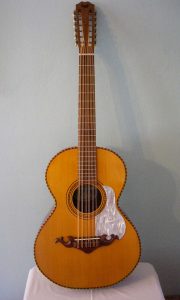 1. Bajo Sexto: A few years back I made a copy of a bajo sexto made in the 1950’s by Martin Macias. Like many of the one man shops of his day, Martin Macias used the wood that was locally available to him. For the guitar which I copied he used walnut for the back and sides, fingerboard and bridge, poplar (which he called “magnolia”) for the neck, and pine for the top. I used all the same woods, but opted for red spruce for the top. I especially liked using the walnut for the fingerboard and bridge as it’s difficult to find a good domestic hardwood for this application. The walnut worked wonderfully and was comparable to many rosewoods which are often used for these parts.
1. Bajo Sexto: A few years back I made a copy of a bajo sexto made in the 1950’s by Martin Macias. Like many of the one man shops of his day, Martin Macias used the wood that was locally available to him. For the guitar which I copied he used walnut for the back and sides, fingerboard and bridge, poplar (which he called “magnolia”) for the neck, and pine for the top. I used all the same woods, but opted for red spruce for the top. I especially liked using the walnut for the fingerboard and bridge as it’s difficult to find a good domestic hardwood for this application. The walnut worked wonderfully and was comparable to many rosewoods which are often used for these parts.
2. Francesca 12 string: Last year I restored two Stella 12 strings from the 1920’s. I have worked on a lot of Stellas over the years, but on the first one of these, I realized that the wood used for the back and sides, which I had always assumed was birch because everyone referred to it as birch, was actually poplar. I had long known that Oscar Schmidt used poplar rather extensively for necks and occasionally fingerboards, but I hadn’t considered that they would have used it for back and sides. The guitars are very often dirty inside and it can be difficult to identify the wood, but on one of the old 12 strings I had to take the back off and upon cleaning the wood I realized that it was poplar. It totally made sense and went along with everything I have always thought about Oscar Schmidt’s production ethic, poplar was inexpensive, it takes stain wonderfully and it doesn’t have pores, which means that you can skip the step of pore filling which is one of the most time consuming steps in finishing, and time is money. I immediately wanted to try building a poplar 12 string but I had to wait until I could find a customer who was interested.
Not to long after I was contacted by a Blind Willie McTell acolyte who requested a guitar like one of Willie’s old Stella 12s. I talked to him about the poplar and he was game. I used red spruce for the top, poplar for the neck back and sides and maple for the fingerboard and bridge. I stained the maple black so that it would look “ebonized”, like the fingerboards on the old Stellas. The guitar turned out great. It was very light in weight, sounded great and looked like it rolled out of the 1920’s.
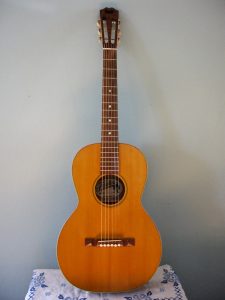 3. Hemlock and White Oak Anunziata – My friend Clancy is a timber framer who has a sawmill. He and I are always talking about wood. Recently Clancy came across some hemlock which had been salvaged from some massive beams in an old warehouse built in the early 1900’s. It had probably grown in Wisconsin before the North woods were clear cut. Clancy had resawn the beams to use in a project and he had some nice quartersawn cutoffs which he gave to me. The more I looked at the hemlock the more it reminded me of some of the wood used on tops of guitars built in the early 20th Century, especially some of the early Chicago made guitars. I used the wood on a couple of projects and I was more than satisfied with the results. It sounded great and with a coat of varnish it immediately look old and warm.
3. Hemlock and White Oak Anunziata – My friend Clancy is a timber framer who has a sawmill. He and I are always talking about wood. Recently Clancy came across some hemlock which had been salvaged from some massive beams in an old warehouse built in the early 1900’s. It had probably grown in Wisconsin before the North woods were clear cut. Clancy had resawn the beams to use in a project and he had some nice quartersawn cutoffs which he gave to me. The more I looked at the hemlock the more it reminded me of some of the wood used on tops of guitars built in the early 20th Century, especially some of the early Chicago made guitars. I used the wood on a couple of projects and I was more than satisfied with the results. It sounded great and with a coat of varnish it immediately look old and warm.
I built a guitar for Clancy and his wife Sara and wanted to use wood which he had given me over the years. I used the hemlock for the top and some white oak for the back and sides. For the neck I used poplar and for the fingerboard and bridge I used some walnut from a tree that I cut down back in my carpenter days. The guitar has a very plain and simple but elegant look to it. It sounds fantastic.
In conclusion, I think it’s up to all of us. As builders we need to try to use more domestic woods, even if it’s only for one or two guitars a year. Experiment with different woods and get educated about them. If builders start using more domestic woods, they will see that it is great stuff and compares very favorably with the exotics, and sometimes exceeds them. As customers, we need to ask builders about domestic woods and consider them as an option. They can be beautiful, sound great and there is a historic precedent for them. Eventually the idea will catch on an some of the big guys will start carrying sets and the bigger makers will use more of them. It’s much like organic food, years ago it was only hippies and back to the landers who would grow and eat organics. It took many years but it eventually caught on and now you can buy organic food at Wal Mart, which is not a bad thing.
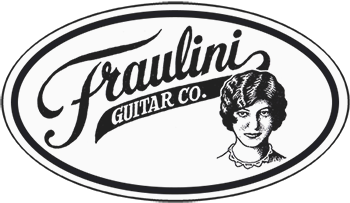
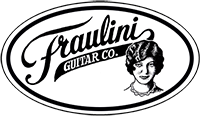

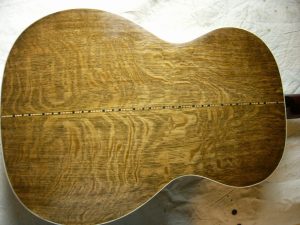

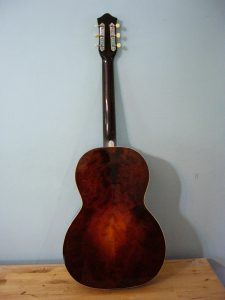
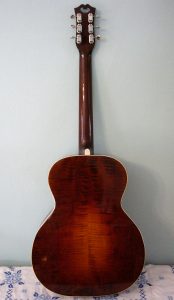
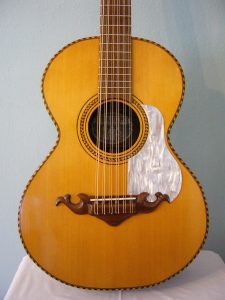
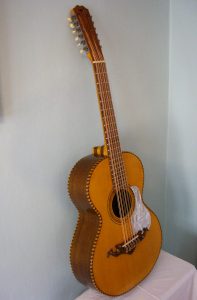
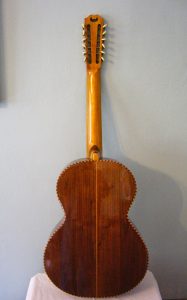
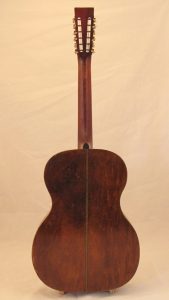
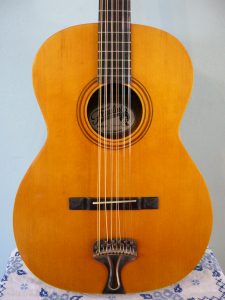
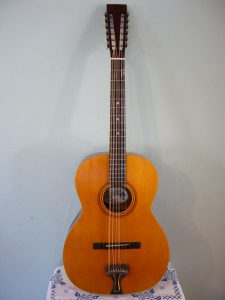

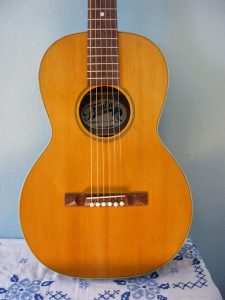
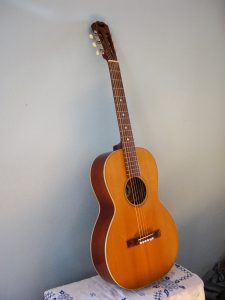


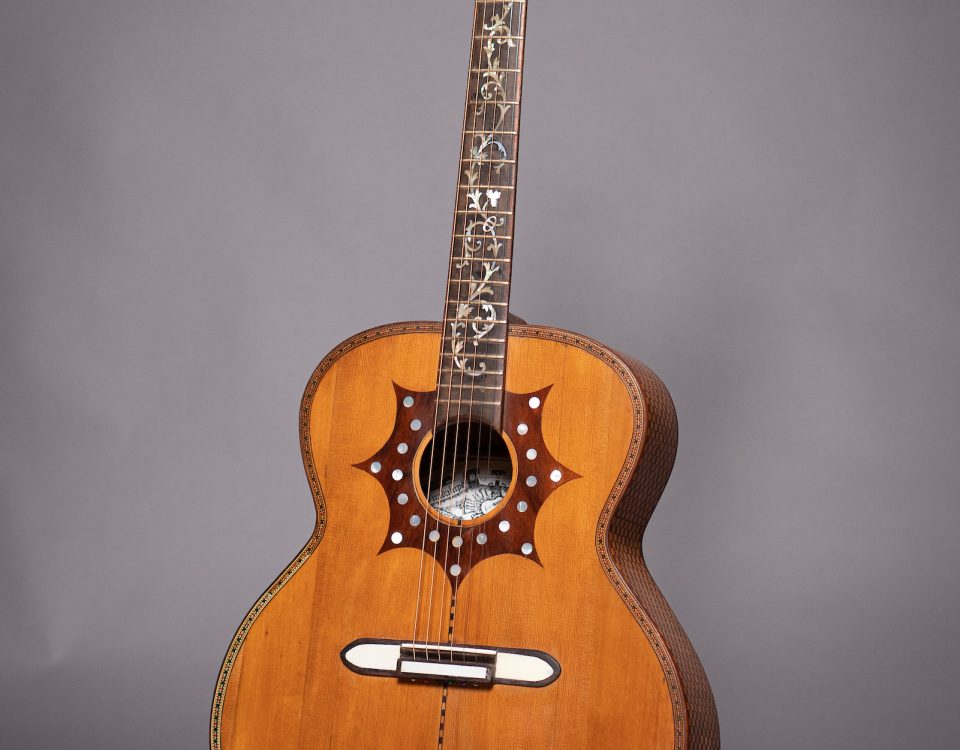
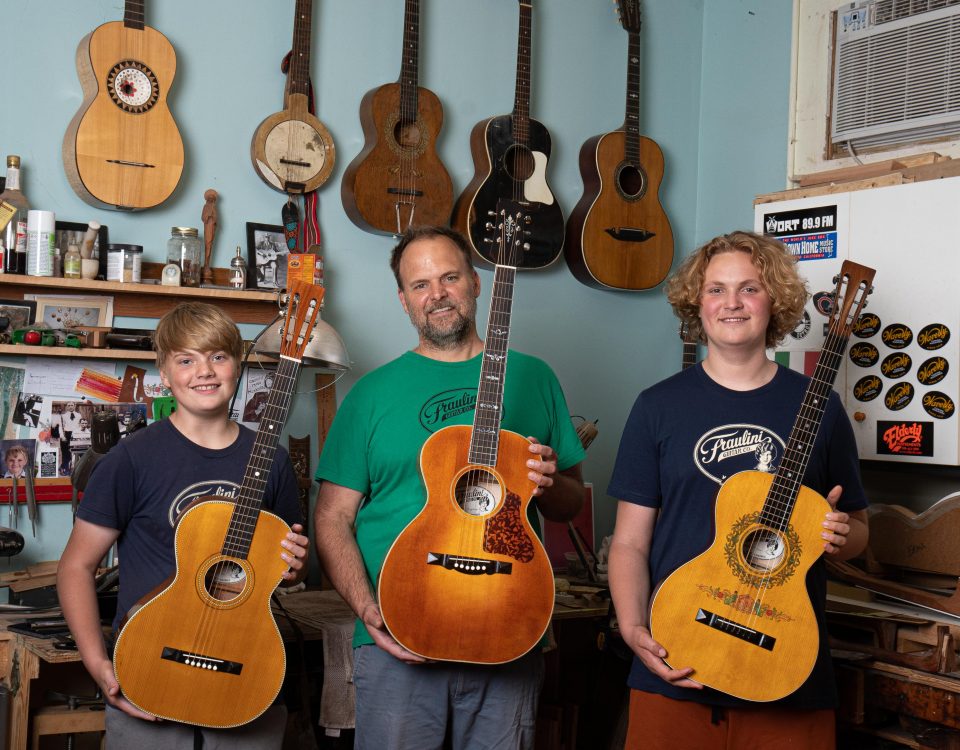
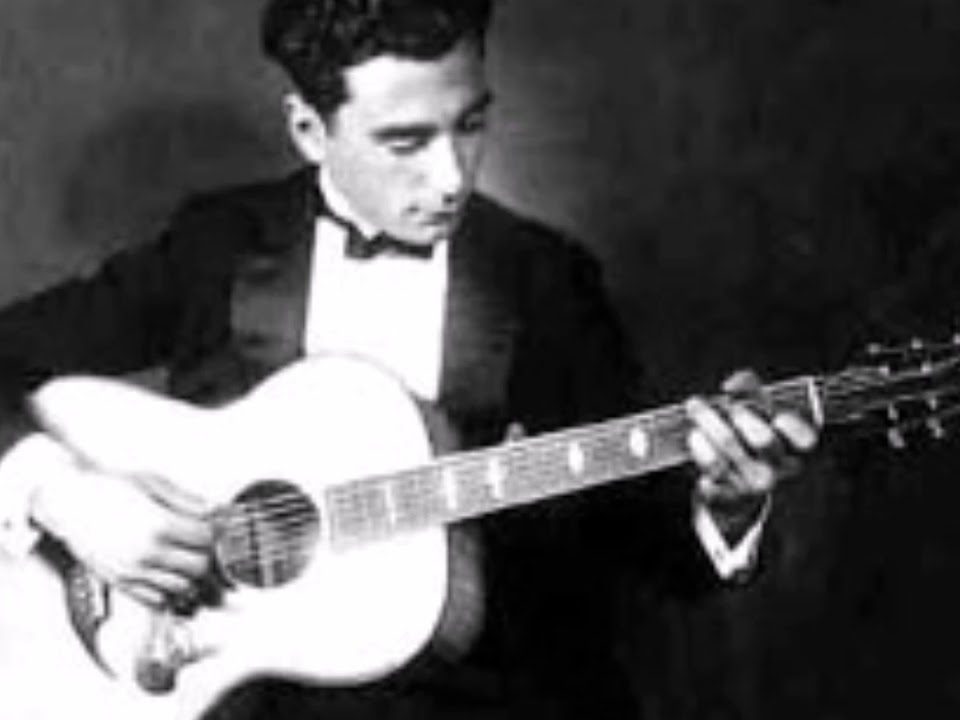
10 Comments
Excellent post, Todd! I am reminded of an exchange you and I recently had after I saw Paul Geremiah playing and said that I couldn't tell what his guitar was made of. You said it was white oak. I had been thinking it looked like oak, but didn't want to say that out loud (figured I'd be mocked!).
You can use domestic wood on my guitar that you are building this summer. Count me in!
I’m going to need to get some new bandsaw blades.
Gibson have introduced a Walnut back and sides and fingerboard j-15 round shouldered jumbo, maple neck, sitka top. They have had quite a bit of trouble with imported woods and the lacey act, I think its great that the tide may be turning with wood species on instruments.
That’s great to hear, though I think their decision was more due to the raid by the feds than environmental awareness. In the old days, Gibson made many A model mandolins out of birch, and they used lots of great hard maple on mandolins and guitars that came from the Upper Pennisula of Michigan. The used a lot of that maple during WWII as well because mahogany was hard to come by. There’s still lots of great maple coming out of that part of the world. It’s highly prized by wood dealers and makes great instruments.
Yeah Todd! I just came upon a couple black locust planks. I'm thinking fingerboards and bridges. Want some?
Hi Devin,
Yes, I’d love to try some locust. I’ve been curious about it as it’s an acacia, like koa. I’ve also wanted to find some good persimmon which is a domestic ebony, but it’s hard to come by. They used to make golf clubs out of it.
There's lots of domestic wood in the nine string that you built for me and I adore it.
Yeah! I am really happy finding this blog here. You know why, yesterday my little son was asking me, the kind of wood used to prepare “Guitars” and I was having no answer. So I really need to read more your blog ahead too, to face that kind of situation again.
I was looking in to this topic, I am learning how to build guitars in southern MN. This will be my 3rd instrument (first 2 being violins, this being my first guitar.) and I purchased a set of white oak from a good friend of mine for $25, he had cut it himself from some barn salvage in northern MN. I am going to build a single-0 and have been very interested in white oak and domestic woods in general. I am so happy I came across this article. I have been leary about the idea of oak because I have never seen it done, though my instructor reinforced my idea with the same points you made, that early 1900's guitars commonly used domestic woods and sound fantastic. Thank you for sharing your experience with the trade, keep up the good work!!
I was looking in to this topic, I am learning how to build guitars in southern MN. This will be my 3rd instrument (first 2 being violins, this being my first guitar.) and I purchased a set of white oak from a good friend of mine for $25, he had cut it himself from some barn salvage in northern MN. I am going to build a single-0 and have been very interested in white oak and domestic woods in general. I am so happy I came across this article. I have been leary about the idea of oak because I have never seen it done, though my instructor reinforced my idea with the same points you made, that early 1900's guitars commonly used domestic woods and sound fantastic. Thank you for sharing your experience with the trade, keep up the good work!!